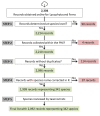Using online databases to produce comprehensive accounts of the vascular plants from the Brazilian protected areas: The Parque Nacional do Itatiaia as a case study
- PMID: 32508509
- PMCID: PMC7250941
- DOI: 10.3897/BDJ.8.e50837
Using online databases to produce comprehensive accounts of the vascular plants from the Brazilian protected areas: The Parque Nacional do Itatiaia as a case study
Abstract
Background: Brazil is one of the most biodiverse countries in the world, with about 37,000 species of land plants. Part of this biodiversity is within protected areas. The development of online databases in the last years greatly improved the available biodiversity data. However, the existing databases do not provide information about the protected areas in which individual plant species occur. The lack of such information is a crucial gap for conservation actions. This study aimed to show how the information captured from online databases, cleaned by a protocol and verified by taxonomists allowed us to obtain a comprehensive list of the vascular plant species from the "Parque Nacional do Itatiaia", the first national park founded in Brazil. All existing records in the online database JABOT (15,100 vouchers) were downloaded, resulting in 11,783 vouchers identified at the species level. Overall, we documented 2,316 species belonging to 176 families and 837 genera of vascular plants in the "Parque Nacional do Itatiaia". Considering the whole vascular flora, 2,238 species are native and 78 are non-native.
New information: The "Parque Nacional do Itatiaia" houses 13% of the angiosperm and 37% of the fern species known from the Brazilian Atlantic Forest. Amongst these species, 82 have been cited as threatened, following IUCN categories (CR, EN or VU), seven are data deficient (DD) and 15 have been classified as a conservation priority, because they are only known from a single specimen collected before 1969.
Keywords: Atlantic Forest; angiosperms; ferns; gymnosperms; lycophytes; plant collection..
Marina M Moreira, Tatiana T Carrijo, Anderson Alves-Araújo, André M A Amorim, Alessandro Rapini, Andrews V S da Silva, Braz A P Cosenza, Claudia R Lopes, Camila N Delgado, Cíntia Kameyama, Dayvid R Couto, Daniel E F Barbosa, Daniele Monteiro, Diego R Gonzaga, Eduardo C Dalcin, Elsie F Guimarães, Elton John de Lírio, Fernando B Matos, Fátima R G Salimena, Felipe A Oliveira, Gustavo Heiden, João M Lanna, José Fernando Baumgratz, José F B Pastore, Juliana R P M Oliveira, Laísa B Barcelos, Lana S Sylvestre, Leandro Freitas, Leandro L Giacomin, Leandro Pederneiras, Leonardo D Meireles, Lúcia G Lohmann, Luciana C Pereira, Luis Alexandre E Silva, Luiz M Neto, Marcelo C Souza, Marcelo Trovó, Marcos E G Sobral, Mário Luís Garbin, Mario Gomes, Marli P Morim, Michelle Christine A Mota, Paulo H Labiak, Pedro L Viana, Pedro Luís R de Moraes, Renato Goldenberg, Rubens Luiz G Coelho, Samyra G Furtado, Sebastião José da Silva-Neto, Thiago B Flores, Valquíria F Dutra, Vinícius R Bueno, Rafaela C Forzza.
Figures
















References
-
- Barroso G. M., Vattimo-Gil I., Brade A. C., Pereira E., Falcão J. I.A., Gomes J. C., Rizzini C. T. Flora do Itatiaia I. Rodriguésia. 1957;20:28–244.
-
- BFG Growing knowledge: an overview of seed plant diversity in Brazil. Rodriguésia. 2015;66(4):1085–1113. doi: 10.1590/2175-7860201869402. - DOI
-
- BFG Brazilian Flora 2020: Innovation and collaboration to meet Target 1 of the Global Strategy for Plant Conservation (GSPC) Rodriguésia. 2018;69(4):1513–1527. doi: 10.1590/2175-7860201566411. - DOI
-
- Brade A. C. Flora do Parque Nacional de Itatiaia. Boletim do Parque Nacional de Itatiaia. 1956;5:7–85.
-
- Briggs J. D., Leigh J. H. Rare or Threatened Australian Plants. Special Publication No. 14. Australian National Parks and Wildlife Service; Canberra: 1988.
LinkOut - more resources
Full Text Sources
Research Materials
Miscellaneous
